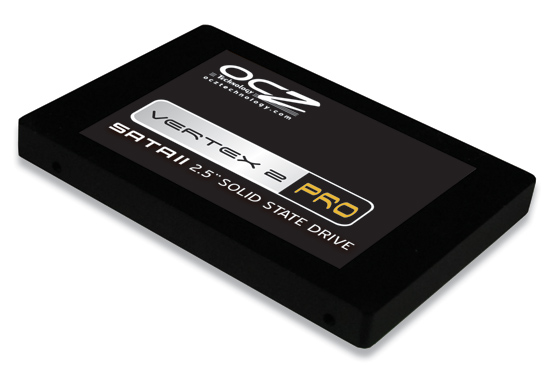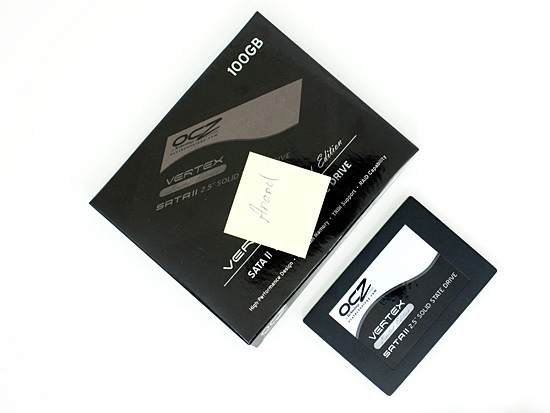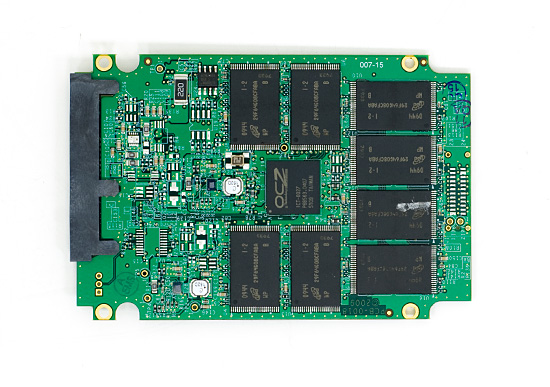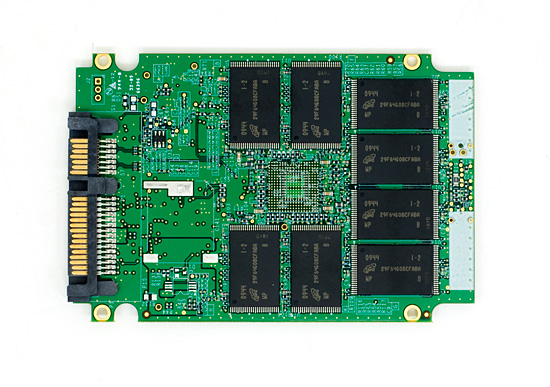OCZ’s Vertex Limited Edition Review & SSD State of the Union
by Anand Lal Shimpi on February 19, 2010 12:00 AM EST- Posted in
- Storage
Back in December I previewed OCZ’s Vertex 2 Pro, the first drive I’d tested to use SandForce’s SF-1500 controller. As you may remember, the controller works in a radical way - by reducing the amount of data written to flash it improves performance and longevity, at the cost of controller/firmware complexity. Not a bad tradeoff for a company trying to sell you expensive SSD controllers. If you want to know more about how it works, I'd suggest consulting my Vertex 2 Pro Preview. If you want to know how SSDs work, take a look at the SSD Relapse.

RIP...
The drive made an impressive showing, easily besting any other MLC SSD I’d ever tested. Unfortunately, it was pre-release hardware, with no known price and no set release date. Not to mention that the company who made the controller was shipping largely unproven technology with an unknown amount of reliability/validation testing.
Since then two things have happened.
First, my SandForce SF-1500 pre-release sample straight up died on me. No warning, no errors, just no data. It only took a couple of weeks worth of real world use to make it happen, but this is why I prefaced the preview with the following:
“Ultimately, the task of putting these drives to the test falls on the heads of you all - the early adopters. It’s only after we collectively put these drives through hundreds and thousands of hours of real world usage that we can determine whether or not they’re sponge-worthy. Even Intel managed to screw up two firmware releases and they do more in-house validation than any company I’ve ever worked with. The bugs of course never appeared in my testing, but only in the field in the hands of paying customers. I hate that it has to be this way, but we live in the wild west of solid state storage. It’ll be a while before you can embrace any new product with confidence.
And it only gets more complicated from here on out. The old JMicron drives were easy to cast aside. They behaved like jerks when you tried to use them. Now the true difference between SSDs rears its head after months or years of use.”
And second, the OCZ Vertex 2 Pro as a product has been canned. Not because of the issue that lead to the untimely death of my drive, but because the SF-1500 controller is just too expensive. I knew that it was going to be pricey at the time I wrote the article, but apparently OCZ thought it could bring the price down by the time it shipped. Needless to say, that didn’t happen.
Instead of the Vertex 2 Pro, OCZ will be shipping the regular Vertex 2 based on SandForce’s slower SF-1200 controller. This SSD will carry a pricetag similar to present day Vertex drives, but hopefully offer better performance. For enterprise customers OCZ will ship the Vertex 2 EX based on the SF-1500 with SLC flash and a ginormous, quarterly-budget depleting pricetag (to be determined). The consumer MLC SF-1500 based Vertex 2 Pro is gone forever.
Here’s where the Vertex Limited Edition comes in:

Despite its name, the Vertex Limited Edition is an MLC SandForce SF-1500 SSD (technically it's a SF-1200/SF-1500 hybrid like the Vertex 2 Pro, but that's a separate issue entirely). It's basically the Vertex 2 Pro with one big caveat - there are only a limited number of these drives being made - 5,000 to be exact. Once they're all gone, that's it.

My Vertex LE is Serial #1. Ebay, here I come!
OCZ apparently got a sweetheart deal on an early batch of SF-1500s. This is the same controller from the Vertex 2 Pro in December, but with an updated firmware (RC1). These are the first drives shipping with RC1 of the SF-1500 firmware and will presumably not die on you after a couple of weeks. While I’ve heard that they may not be enterprise worthy, they are apparently fit for desktop use. OCZ has said that in its internal testing there haven't been any cases of a bricked Vertex LE. The same was not true during the Vertex 2 Pro test period. Now here comes the problem.

The OCZ Vertex Limited Edition. That's a SandForce SF-1500 controller under that OCZ logo in the middle.
I literally just received my drive 24 hours ago. Just like its ancestor, this thing will be put through the wringer for the coming weeks and months. However long it takes to make sure it is worthy of your dollars. The problem is that these drives are limited in quantity, chances are they will all be gone by the time I figure out whether or not they are worthy of a glowing recommendation.
What makes the Limited Edition so special is that because of OCZ’s great pricing on the SF-1500 the 100GB Vertex LE will be selling for $399 ($829 for the 200GB version) - roughly the same price as a 128GB Indilinx based Vertex drive. And in case you’re wondering, yes it performs identically to the Vertex 2 Pro I previewed last year:
| OCZ Vertex LE 100GB | OCZ Vertex 2 Pro 100GB | |
| 4KB Random Write | 51.2 MB/s | 50.9 MB/s |
| 2MB Sequential Write | 252.7 MB/s | 252.0 MB/s |
| 4KB Random Read | 52.0 MB/s | 51.3 MB/s |
| 2MB Sequential Read | 265.3 MB/s | 265.3 MB/s |
| PCMark Vantage Overall | 16827 | 16767 |
| PCMark Vantage HDD | 39288 | 39970 |
| AT Bench - Light | 884 IOPS | 890 IOPS |
| AT Bench - Heavy | 701 IOPS | 705 IOPS |
| AT Bench - Gaming | 319 IOPS | 319 IOPS |
For roughly the same price per GB you’d pay for an Intel X25-M G2, you’re getting a much faster drive. The only issue is that its reliability is unproven. To calm your fears, OCZ is selling the Vertex LE with a 3 year warranty.

Barring any unforeseen issues, the drives will go on sale next week. Risky business.
I should note that we’ve seen vendors get quite opportunistic with hot SSDs in limited quantities before. There’s always the chance that these Vertex LEs will sell for more than their MSRP.
The nifty OCZ Toolbox I showed in my Vertex 2 Pro preview presently doesn’t work with the Vertex LE. The application looks for SandForce in the controller id, which is absent from these unbranded SF-1500 controllers that SandForce unloaded. By the time the drives ship though there should be a custom version of the OCZ Toolbox ready. TRIM is supported and works perfectly under Windows 7.
Unlike the Vertex 2 Pro sample I tested, the Vertex LE doesn’t have the ungodly expensive capacitor on its PCB. As I mentioned before, these aren’t designed to go into servers and thus the supercap won’t be missed. Performance on the drive is great and I haven’t had any issues thus far in my testing, but there’s a long road ahead of me.
The RC1 firmware is brand new to me. I’ll be putting the drive through its paces but given that the units will go on sale next week I decided to share my initial thoughts today rather than wait.










83 Comments
View All Comments
v12v12 - Tuesday, February 23, 2010 - link
"To calm your fears, OCZ is selling the Vertex LE with a 3 year warranty."Umm 3yrs is CRAP! It's the industry standard among ALL HDs... again, how many times do I have to catch Anand-staff soft-wrist-slapping these con-artist manufacturers?! Who's "assured" with a 3yr warranty vs what? I haven't seen any manu offering lower? So how's that a selling/assurance point... let alone if it's even VALID to list in this article?
What you should have said (if at all) was:
"To calm your fears, OCZ is selling the Vertex LE with a STANDARD 3 year warranty (just like everyone else)." Hahaha.
I just don't get how you can continue to soft-scold (more like a notation) these manufactures when you and I KNOW it's crap. Well Okay I DO know; you're smart and running a business/review site (pro-business) and you don't wanna bad mouth these guys like you OUGHT to do. So instead you'll give them wrist slaps at the end of all the journalist-sensationalism in order to wash over the apparent chicanery of these businesses, so they'll keep sending you beta/new samples... Yes I know how the POLITICS of "business" works these days; sucks for the avg-minded consumer who totally misses keystone issues like this for all the hype and grandeur laced commentary... Sigh, the consumer-cattle loses again.
OWC Grant - Tuesday, February 23, 2010 - link
FWIW to this discussion thread and wasn't covered in the brief mention, the OWC Extreme Enterprise comes with an enterprise class level warranty...FIVE years. So, based on pricing and other similarities, will leave it up others to decide what the best value/performance ratio is in SSDs.kunedog - Tuesday, February 23, 2010 - link
Let's also not forget that he *never* acknowledged the near-immediately stratospheric pricing of Intel's G2 X-25M, right after he praised its affordability:http://www.anandtech.com/storage/showdoc.aspx?i=36...">http://www.anandtech.com/storage/showdoc.aspx?i=36...
He mentioned the firmware problems and lack of stock once but never the pricing.
ONLY now, over 6 months later, do we see prices anywhere near what he predicted at release:
80GB for $220
http://www.newegg.com/Product/Product.aspx?Item=N8...">http://www.newegg.com/Product/Product.aspx?Item=N8...
160GB for $430
http://www.newegg.com/Product/Product.aspx?Item=N8...">http://www.newegg.com/Product/Product.aspx?Item=N8...
The 160GB comes with a free Apricorn USB enclosure, the same one "randomly plugged" here by Anand. It's a strange coincidence to see two sites decide to associate it with SSDs (why would you put an SSD in an USB enclosure?).
shin0bi272 - Monday, February 22, 2010 - link
I thought I saw a review on anandtech a few months ago about the corsair p128 which was supposed to be a great ssd. But its not included on these benchmarks. Its supposed to have 220mb seq read and 200mb seq write. yet its not included? why?OWC Grant - Monday, February 22, 2010 - link
Glad to see so much interest in SSD!As Anand was made aware, our earliest units went out to reviewers and we contacted him and other reviewers to get these units back upon learning of a firmware revision that became available early Feb. In direct communication with him, he noted that neither firmware version had any effect on the performance.
All other OWC SSD units in the field (and available with same day to 1 day delay shipping from OWC) do have the latest firmware revision.
So, we are not "a bit behind OCZ" in this regard.
Hope this clears up the matter...and that you get an OWC SSD for yourself!
smith11 - Monday, February 22, 2010 - link
There's something that I'm not getting...If there's 0.5x write amplification because of real-time compression, why wouldn't the effective capacity be a good bit higher than (the non-reserved part of) the physical capacity ???
GullLars - Monday, February 22, 2010 - link
When i was reading this test, i couldn't help but think on several occasions that a cheap RAID of 3-4 intel x25-V from ICH10R would beat many of the drives tested here, and at a lower price.4 x25-V in RAID 0 gives 160GB capasity, roughly 600 MB/s seq read (limited by ICH10Rs bandwidth), about 140-150 MB/s seq write, around 100.000 4KB random read IOPS (400MB/s) at higher queue depths, and about 40.000 4KB random write IOPS (120MB/s). At a price point around $400-450, wich is about the same as Intel x25-M G2 160GB costs...
I think it would be great if Anand could do a test with 4 x25-V in RAID 0 from ICH10R to demonstrate a budget concious enthusiast setup.
semo - Monday, February 22, 2010 - link
Hi Anand,Great article. Any word on PCI-e SSDs? Are you leaving them out because of high costs or other reasons?
Also, good to know that you have our backs if those SSDs start crapping out. Without people like you companies get away with it for a long time.
rubbertoe - Sunday, February 21, 2010 - link
Looks like Amazon is also selling the 100G version:http://www.amazon.com/gp/product/B0035RQZSG/ref=pd...">http://www.amazon.com/gp/product/B0035R...X0DER&am...
Can someone confirm this is the drive that was reviewed? With selling only 5,000 does anyone have any idea how they will be distributed into the retail channels?
RT
neoflux - Sunday, February 21, 2010 - link
The OCZ Agility uses Intel 50nm or Toshiba 40nm flash.The OCZ Solid 2 uses Intel 34nm flash.
The OCZ Vertex uses Samsung flash, but what SIZE?
And based on that size, if the controller is the same as Anand mentioned a few articles ago, is the Solid 2 faster or at least the same speed-wise as the Vertex?
I did find that the Solid 2 may actually have some sort of 'crippled' Indilux controller, but that was just some forum, not an article.
I have gone back through all the Anand articles and googled everything I could think, but could not find the answer.
Someone enlighten me as to the size of the flash and the speed compared to the Vertex?